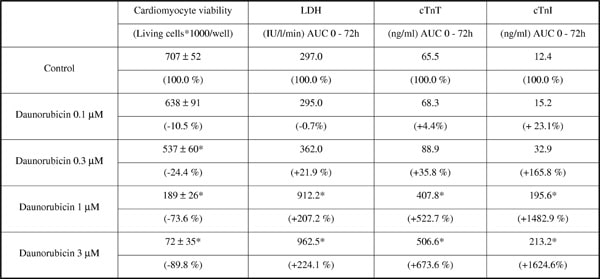Risk of cardiotoxicity is the most serious drawback of the clinical usefulness of anthracycline antineoplastic antibiotics. Early, accurate and preferably non-invasive detection of cardiac injury is therefore of crucial importance. Previously we have shown that cardiac troponin T (cTnT) is a useful biochemical marker of anthracycline-induced cardiotoxicity in vivo, using a model of chronic daunorubicin-induced heart failure in rabbits (1). In the present study, we examined the release kinetics of cTnT and cTnI using an in vitro model of isolated rat neonatal ventricular cardiomyocytes (NVCM, 72-hour treatment with 0.1 – 3 µM of daunorubicin). Daunorubicin-exposed cardiomyocytes typically increased beating frequency, which was in groups with 1 and 3 µmol/l followed by irregular activity, discontinuation of cellular monolayer and eventually contractile arrest. While in culture media of control cells LDH activity was spontaneously increasing over time, cTnT and cTnI concentrations remained unchanged throughout the experiment. LDH activity and both troponin concentrations were dose- and time-dependently increasing in response to daunorubicin exposure and were negatively exponentially related to cardiomyocyte viability. With 3 µM daunorubicin, the relative increase of AUC of cTnT and cTnI was 2.4 and 5.3-fold higher than the increase of LDH activity, respectively (Table 1). Hence, the troponins can become not only the bridge between the clinical and experimental studies of drug-induced cardiotoxicity but also the linkage between the preclinical experiments in vitro and in vivo.
Life Sciences 2007 (2007) Proc Life Sciences, PC341
Poster Communications: In vitro study of cardiac troponins as biochemical markers of anthracycline-induced cardiotoxicity
T. Simunek1, M. Adamcova2, H. Kaiserova1, M. Sterba2, O. Popelova2, A. Potacova2, E. Kvasnickova1, V. Gersl2
1. Faculty of Pharmacy, Dept. Biochemical Sciences, Charles University in Prague, Hradec Kralove, Czech Republic. 2. Faculty of Medicine in Hradec Kralove, Charles University in Prague, Hradec Kralove, Czech Republic.
View other abstracts by:
Table 1 – Cardiomyocyte viability after the 72h daunorubicin exposure (means ± S.E.M.) and cummulative release of LDH cTnT and cTnI over the 72h incubation period (AUCs – given as medians)
Where applicable, experiments conform with Society ethical requirements.

